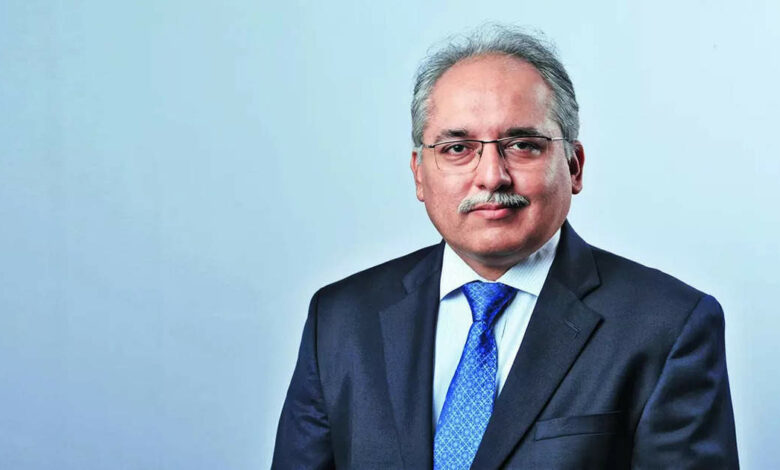Crisil CEO: Indian economy is resilient… changes in bilateral trade are a huge opportunity, says Crisil CEO

The latest GDP growth numbers surprised everyone. There are divergent views on it and we aren’t seeing private capex yet. What are the corporates telling you?
There are a few parts to this. One is the PLI (production-linked incentive scheme). It’s very targeted – 15 sectors – and it’s going to happen. Then there is conventional capex, the point that you are talking about. We are looking at capacity utilisation across multiple segments right now. What we are seeing is that in the top eight key segments, the capacity today is higher than the decadal average capacity utilisation that we have seen across those segments whether you take cement, steel, oil and gas, etc. Cement and steel plants are already expanding, refining is talking about green capex investment. Capex investment in these companies is at 13-14% versus 7-8% earlier. We are talking 13-14% growth in fixed assets. They have now started investing at a higher pace than earlier.
The next question is about the sustainability of this growth. Can this be repeated?
The resilience of the Indian economy is on the back of continued domestic demand and consumption. We are not seeing the impact that we would have expected with the interest rates moving up. Interest rates went up by 250 basis points and because of that, we will see some impact on consumption. We have moderated our next year’s GDP (growth projection) to 6.8%. Global trade continues to see an impact because Europe still continues to be slow. The US is better. That will have its own impact on the Indian economy. Further, the fiscal discipline of the government means that its expenditure would be a little controlled. We are hoping for a normal monsoon, so the agriculture sector will be okay. At 6.8%, India would still be the fastest-growing major economy.
If the government slows spending, the private sector has to step in. Which would be the top?
We are going to see investments in three different areas. On PLI, the government has put a scheme – ₹3 lakh crore is expected. ₹1 lakh crore has already been done and another ₹2 lakh crore is likely to happen in the next two to three years. Most of it will happen in 2024 and 2025, that’s where the impact will be because the scheme is being driven in that fashion. You also have emerging sectors – semiconductors, and renewables.
What is beyond these headline projects…
There’s a huge opportunity for India at this point in time because there are a lot of changes happening from a bilateral trade perspective. There was a global supply chain network, which was set up 10-20 years back. People went to the lowest-cost locations and went for scale. That’s how China and some of the other countries came up. I think at this point in time, with all the things which have happened from the geopolitical side, what’s happening from the perspective of friendly relations between countries presents a huge opportunity for India.
Even 20 years ago, there were opportunities being spoken of. What is the difference between the opportunities from then and now?
The entire logistics of getting things into India if you’re importing from wherever you are – for instance, in Indian ports, the turnaround time has actually become half versus 10 years back. Then you have road connectivity. The connectivity of highways right up to whatever locations you want. Port connectivity, rail connectivity and road connectivity – the investments which have been made in these three sectors – are showing you traction. The interconnectedness of these three – when you talk about creating logistics paths, you make sure that you’re enabling that. Now, there are people who are ready to commit. That only happens when all of this is available.
How has that helped?
The other enabler is on the digital infrastructure side. Just look at FASTags, look at GST, which has removed all the toll roadblocks. The efficiency has gone up. Earlier, a truck in India could only do two trips from one part to the other at best in a month. Today, six trips are possible. That is the conversion because of the efficiency that has come in.
What more needs to be done?
Of course, we need to look at reforms, because ultimately the pace of economic growth will depend on what sort of reforms are being done. Whether there are labour reforms, whether there are land acquisition reforms. I think those will need to be looked at. Agricultural reforms – because agriculture still remains a large labour force. I would also look at the productivity side of things. We expect manufacturing as a percentage of GDP to grow because we are seeing a huge impetus there – it’s 17.5% of GDP and likely to go to 20% as far as we think.
Crisil estimates that ₹30-35 lakh crore of debt will be needed to be funded by the private sector alone for capex. How do you fund it with a shallow bond market?
There are a couple of things happening. One is, that with global bond index inclusion happening, there will be space created for investment in the infrastructure sector. The other is that if you look at some of the parameters of the A-rated companies now with the AA companies in 2016-17, they are virtually similar. What this means is that A-rated companies today are where AA companies were six to seven years back. If you look at risk-adjusted returns for A-rated companies today, you are seeing a 50-basis-point higher return versus what you see in AA-rated companies. A-rated companies are improving in their fiscal discipline and that is a huge opportunity. Financial savings in mutual funds are largely going to equity. If you’re able to demonstrate stability and good risk-adjusted returns, it will come back into debt. Global investors would want to invest in bonds in the infrastructure space.
Banks are key for any growth funding. Given the scramble for deposits, how do you see things unfolding?
We see an increase in the cost of deposits for banks because it’s taking time for the costs to be passed down. We will see some impact on net interest margins by maybe 10-20 basis points. But the return on assets is healthy. Also, they are going to see some benefits on credit costs because of just the sheer efficiency. The impact might be offset by some of the benefits that banks may see on credit costs. Overall, we don’t see too much of a challenge on profitability. There will be some impact which is likely to happen but not necessarily something which we are worried about – we don’t think it will be material.
With the RBI having curbed excessive growth in some lending segments, how will NBFCs fare?
For NBFCs, we expect the growth to continue. It might be one or two percentage points lower than last year. Housing and vehicle demand is going to continue, The only place where you might see some impact is the unsecured retail credit where growth is already moderating. Let’s be very clear, it is already moderating because that is what is the intent – to bring that growth down, to be mindful about that growth.
This means that the NBFCs will have to tighten their assurance and their credit underwriting processes. They will need to make sure that the due diligence that they are applying to that portfolio is stronger. Their costs have anyway gone up because the risk provisioning has gone up from the banks’ side. What we are seeing so far is that it might have a few basis points worth of an impact on the growth in the retail credit side, which is unsecured credit. But all the other segments are likely to continue to grow.
Source link





